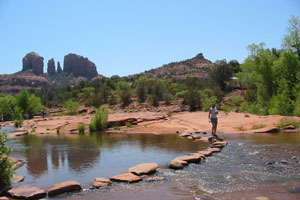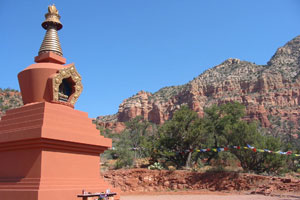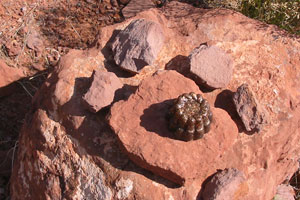
“Hey, do you know where the vortex is?”
A guy in his twenties with chin-length hair was calling uphill to where my husband and I were seated on a red-rock boulder. This kind of conversation is fairly typical in Sedona, Arizona, the New Age capital of the United States.
“I think we’re sitting on it,” I called down. It was nearly sunset, our last night in Sedona, and we had spent quite a bit of time consulting our vortex map to find the exact "power spot"—a concentration of the earth’s energy—at Airport Mesa, one of Sedona’s four “official” vortexes (there are also six other sites where people feel special energy). Unfortunately, there were no signs posted saying “Vortex Here,” so you had to go by soft indicators, like a severely twisted juniper tree (“the stronger the energy, the more of an axial twist in the tree’s branches,” advised one pamphlet). We had found a deformed juniper and sat down in front of it to gaze at the setting sun.
“No, I don’t think that’s it,” the young man said. “I think it’s higher up on the other side of the hill.”
Oh dear. No wonder I wasn’t feeling anything unusual.
Nothing but the intense dry heat of a three-year drought that has been making the entire Southwest a tinderbox this summer. There was a wildfire burning in nearby Oak Creek Canyon. We could see the smoke in the distance and a small plane flying over to douse it. Unfortunately, more fires started in this beautiful pine forest after we left, taking more than a week to control.
At this point, though, I admit I was more concerned with tracking down the magical vortex energy that many call “life-changing.” Would it change my life? I certainly wasn't the first to come here asking that question.
Sedona’s beauty is legendary. Set at the bottom of a canyon, the city is surrounded by immense red sandstone and limestone cliffs and mesas, sculpted by erosion into fantastic shapes that change from gold and orange to crimson and purple at different times of day.
For thousands of years, Native Americans in the area held sacred ceremonies in the canyon (none would consider living here; it was holy ground). In the 1950s, artists and film stars discovered Sedona. Its stunning backdrop was used for Westerns like “The Angel and the Badman” and “Johnny Guitar.” Walt Disney, who lived here then, is said to have based a Disneyland roller coaster on Sedona’s massive Thunder Mountain. Sedona now has 8000-10,000 permanent residents, with four million tourists visiting annually. A Northern Arizona University study done in 1995 showed that 64 percent of Sedona’s visitors were seeking a spiritual experience.
The word “vortex” came into use in Sedona around 1980, when a spiritual channel named Page Bryant used dowsing and her intuition to locate power spots in the landscape where the energy of the earth breaks the surface. People say effects of the vortexes range from subtle (a feeling of peace or delight) to tangible (a rush of new ideas or visions, a tingling sensation in your body) to extremely powerful (your hair stands on end). A massage therapist I went to on this trip told me, “I turned a corner while hiking and was almost blown off my feet. It was like walking into an electrical field.” Surprisingly, her experience didn’t happen at a known vortex site, and she had been in Sedona for two years and hadn't felt anything unusual before. So how would I be affected in just three days?
We decided to take one of the advertised vortex tours. One handout showed a joyous-looking woman named Suzanne McMillan-McTavish raising her arms in front of Cathedral Rock vortex, a full moon rising in the background. The testimonials all sang her praises, but we soon learned that Suzanne no longer gave tours, but trained guides. We were assured by the woman at the tour company office, though, that the tour would be “fully ceremonial and spiritual.”
My husband and I turned out to be the only ones on the tour. Our guide Ron, a soft-spoken Californian with a graying beard, in a tie-dyed T-shirt and cowboy hat, had only been there for a few months. My husband, a skeptic on spiritual matters, was unconcerned, but I am a believer in all things metaphysical and felt a bit let down—how deep could his knowledge of vortexes be? But Ron was a sweet guy, well-acquainted with Native American spirituality, and described himself as a spiritual seeker.
At a mesa overlooking the whole of Sedona, Ron gave us an overview of the history and geology of the area, explaining that the iron oxide that gave the Red Rocks their striking color acted as a natural magnet to conduct earth-based energy. Time for a ceremony: He pulled out a pouch and placed some loose tobacco in our right hands. He had us hold our hands to our hearts while we spoke our prayers and intentions. Then we held hands kiva-style (in a sacred circle) while he invoked gods and spiritual beings of many faiths--the Archangels, Buddha, Christ, Mother Mary, Kwan Yin, Native American Ancestors, Krishna—to support our intentions. We ended with “A-ho!”
Vortex talk is a mix of the scientific and the squishy. Ron explained that vortexes could have masculine (electric) or feminine (magnetic) energy, which he termed “outflow” or “inflow,” or they can be a balance of the two. You know you’re at a masculine vortex when you are full of energy, ideas, and confidence. (It was at a masculine-energy vortex, Airport Mesa, that Ron said he set the intention to be a tour leader.) By contrast, a feminine vortex has a calming, healing effect. And balanced energy—well, it’s a good thing, whatever it is. You can find balanced vortexes at Boynton Canyon or Indian Gardens, each 15 minutes from the center of town in opposite directions.

Our first vortex stop was at a Buddhist stupa, or sacred monument, built two years ago by a Tibetan Buddhist organization ( Kunzang Palyul Choling of Sedona
) dedicated to world peace and compassion. The shrine is painted a red rock color with a golden Amitabha Buddha (the Buddha of infinite light) in an alcove—and is in a precise line with Chimney Rock, a tall, thin monolithic vortex site, and Thunder Mountain. It’s a perfect example of one spiritual tradition layered on another, like churches in Europe built on goddess shrines and pre-Christian holy springs. The spiritual energy is there—only the outward expression is different. The Buddhist group calls this place a “spiritual generator,” a perfect mandala (representation of the cosmos) where prayers will be heard and answered. The nuns who tend the shrine daily pray without ceasing. Colorful prayer flags ring the area, and a community center, temple, and meditation gardens are planned for this site.
We circled the Buddha sculpture three times and left an offering on a table in front where others had left theirs (including bottled water and Snapple ice tea—precious commodities in the increasing heat). A feeling of deep peacefulness made me think this was a feminine energy vortex. But Ron said that Chimney Rock and Thunder Mountain are masculine. Oh well.
We headed for Red Rock Crossing and Cathedral Rock, both of which are said to have big feminine energy. As we got to the cool, rushing waters of Oak Creek, we did our second ceremony; we crossed to the middle on red stepping stones, held our arms out, and faced downstream to let our “stuff” go. Then we turned around to let the energy of the creek flow into us. We hiked through a sandy wash to get as close as we could to Cathedral Rock, which is split by its two interior twin monoliths dubbed “The Lovers.” (There was certainly a story in here somewhere, but we didn’t learn it.) In the shade of a cottonwood tree, little white tufts locals call “summer snow” were floating everywhere. We felt like children in a fairy tale.
We had our parting ceremony in the parking lot outside the tour office on Rte. 89A, Sedona’s main street. Ron led us in a Native American prayer, aided by hand gestures: “I honor Father Sky; I honor Mother Earth. All the directions all around. I bring them into my heart. I give thanks for all the blessings I have received, known and unknown.” We ended with a hearty “A-ho!” and a group hug.
Ron had quoted Suzanne on the three things you need to do if you're going to actually live in Sedona: “Come from your heart, serve other people, and walk the land daily.”
Our effort to walk the land the previous day had almost ended in disaster, though in hindsight, it might have been a mystical experience. We had set off to hike the Airport Loop, a 2 ½-mile hike around a high cliff, in the early morning. We were already starting to get toasted on one side when we heard something above us. It sounded to me like a low growl. “Um, did you hear that?” I asked my husband. “Yeah,” he said and we significantly picked up the pace. It sounded like a mountain lion. We had been told mountain lions tend to shy away from people, but the drought and unusually high temperature—along with the continuing loss of their habitat due to development—was bringing them down from the hills in pursuit of mule deer, their typical prey. However, I wondered, what if a lion happened to run into a nervous, middle-aged, slow-moving human? The blood rushed to my head—my husband said I turned somewhat purple—and we zipped along for a half-hour until we encountered another hiker.
You know how they say that people can be angels in disguise? I think this guy really was. He arrived out of nowhere with words of encouragement… “Only 45 minutes ‘til the end of the trail…there’s some shade…it’s not steep…” and then he disappeared.
When we got back, I spent the rest of the day lying down with a massive headache, drinking water and feeling grateful that I hadn’t either dropped from heatstroke on the trail or been a mountain lion’s meal. Or maybe it was our totem animal after all…
Back at the Mesa, the young man who told us we weren’t sitting on a vortex reappeared. We had been chatting with his mom, who introduced him as an artist named Jason. As a parting gift, Jason very sweetly handed us…something. It was brown with flecks of gold. It looked like a hunk of molded Jello, with glittery metal instead of fruit suspended inside.

“It’s orgonite
,” Jason explained. “Google it when you get home. I molded it today at Bell Rock (a vortex site we hadn’t yet visited). Keep it outside for two days to let the gases escape. When you get home, put it near your computer or TV. It cleans out electromagnetic radiation...”
Only in Sedona. We thanked Jason for the gift and determined to put it between us and harmful rays.
Unfortunately, though, we didn’t have two more days to let the orgonite’s gases escape—apparently a necessary part of orgonite-making
; we were leaving for the airport the next day. And by morning the stuff was still emitting noxious fumes. We were afraid to bring it on the airplane; what if it set off a metal detector? What if airline security got a whiff and thought we were packing more than a spiritual, stinky rock?
Still, it was a spiritual gift…the only thing we could think of to do was return it to Bell Rock vortex. This was our last stop in Sedona. A mile from the Bell Rock trailhead, we did a ceremony, thanking Jason for the gift and giving the orgonite back to the vortex. Then we put it on a red rock and left.
If you see it there, you’re welcome to bring it home. The gases have probably escaped by now.

